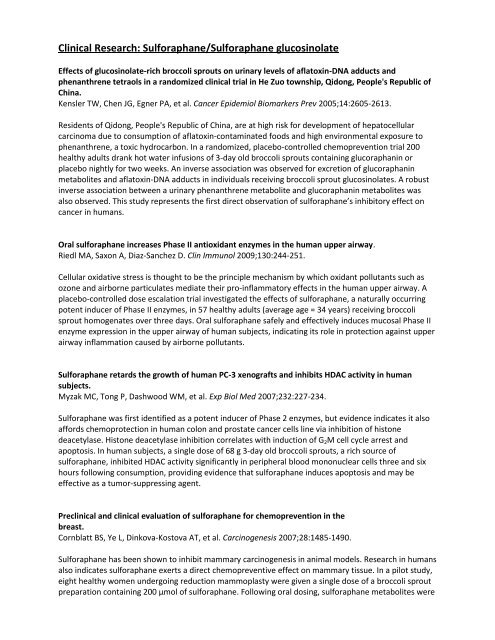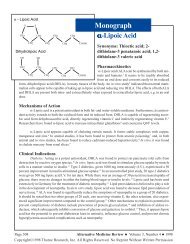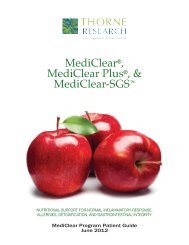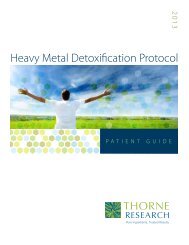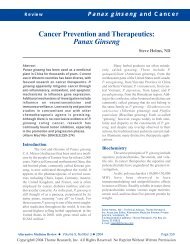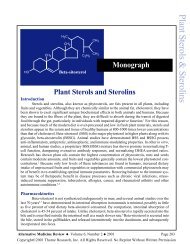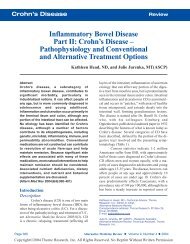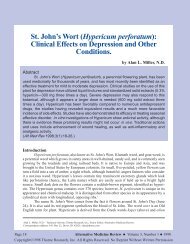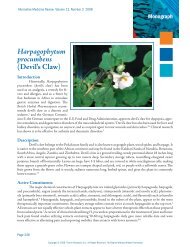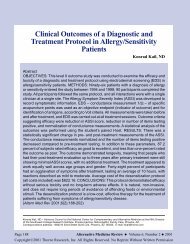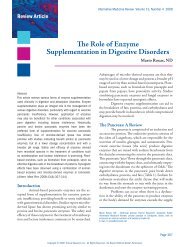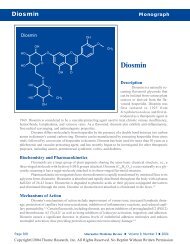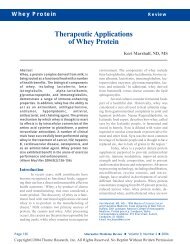Sulforaphane/Sulforaphane glucosinolate - Thorne Research
Sulforaphane/Sulforaphane glucosinolate - Thorne Research
Sulforaphane/Sulforaphane glucosinolate - Thorne Research
Create successful ePaper yourself
Turn your PDF publications into a flip-book with our unique Google optimized e-Paper software.
Clinical <strong>Research</strong>: <strong>Sulforaphane</strong>/<strong>Sulforaphane</strong> <strong>glucosinolate</strong><br />
Effects of <strong>glucosinolate</strong>-rich broccoli sprouts on urinary levels of aflatoxin-DNA adducts and<br />
phenanthrene tetraols in a randomized clinical trial in He Zuo township, Qidong, People's Republic of<br />
China.<br />
Kensler TW, Chen JG, Egner PA, et al. Cancer Epidemiol Biomarkers Prev 2005;14:2605-2613.<br />
Residents of Qidong, People's Republic of China, are at high risk for development of hepatocellular<br />
carcinoma due to consumption of aflatoxin-contaminated foods and high environmental exposure to<br />
phenanthrene, a toxic hydrocarbon. In a randomized, placebo-controlled chemoprevention trial 200<br />
healthy adults drank hot water infusions of 3-day old broccoli sprouts containing glucoraphanin or<br />
placebo nightly for two weeks. An inverse association was observed for excretion of glucoraphanin<br />
metabolites and aflatoxin-DNA adducts in individuals receiving broccoli sprout <strong>glucosinolate</strong>s. A robust<br />
inverse association between a urinary phenanthrene metabolite and glucoraphanin metabolites was<br />
also observed. This study represents the first direct observation of sulforaphane’s inhibitory effect on<br />
cancer in humans.<br />
Oral sulforaphane increases Phase II antioxidant enzymes in the human upper airway.<br />
Riedl MA, Saxon A, Diaz-Sanchez D. Clin Immunol 2009;130:244-251.<br />
Cellular oxidative stress is thought to be the principle mechanism by which oxidant pollutants such as<br />
ozone and airborne particulates mediate their pro-inflammatory effects in the human upper airway. A<br />
placebo-controlled dose escalation trial investigated the effects of sulforaphane, a naturally occurring<br />
potent inducer of Phase II enzymes, in 57 healthy adults (average age = 34 years) receiving broccoli<br />
sprout homogenates over three days. Oral sulforaphane safely and effectively induces mucosal Phase II<br />
enzyme expression in the upper airway of human subjects, indicating its role in protection against upper<br />
airway inflammation caused by airborne pollutants.<br />
<strong>Sulforaphane</strong> retards the growth of human PC-3 xenografts and inhibits HDAC activity in human<br />
subjects.<br />
Myzak MC, Tong P, Dashwood WM, et al. Exp Biol Med 2007;232:227-234.<br />
<strong>Sulforaphane</strong> was first identified as a potent inducer of Phase 2 enzymes, but evidence indicates it also<br />
affords chemoprotection in human colon and prostate cancer cells line via inhibition of histone<br />
deacetylase. Histone deacetylase inhibition correlates with induction of G2M cell cycle arrest and<br />
apoptosis. In human subjects, a single dose of 68 g 3-day old broccoli sprouts, a rich source of<br />
sulforaphane, inhibited HDAC activity significantly in peripheral blood mononuclear cells three and six<br />
hours following consumption, providing evidence that sulforaphane induces apoptosis and may be<br />
effective as a tumor-suppressing agent.<br />
Preclinical and clinical evaluation of sulforaphane for chemoprevention in the<br />
breast.<br />
Cornblatt BS, Ye L, Dinkova-Kostova AT, et al. Carcinogenesis 2007;28:1485-1490.<br />
<strong>Sulforaphane</strong> has been shown to inhibit mammary carcinogenesis in animal models. <strong>Research</strong> in humans<br />
also indicates sulforaphane exerts a direct chemopreventive effect on mammary tissue. In a pilot study,<br />
eight healthy women undergoing reduction mammoplasty were given a single dose of a broccoli sprout<br />
preparation containing 200 µmol of sulforaphane. Following oral dosing, sulforaphane metabolites were
eadily measurable in human breast tissue. Both detoxification enzyme gene transcripts NADH quinone<br />
reductase (NQ01) and heme oxygenase-1(HO-1) were measureable in the excised breast tissue,<br />
indicating cancer blocking activity after sulforaphane consumption. These findings provide a strong<br />
rationale for evaluating the protective effects of a broccoli sprout preparation in clinical trials of women<br />
at risk for breast cancer.<br />
Dietary sulforaphane-rich broccoli sprouts reduce colonization and attenuate gastritis in Helicobacter<br />
pylori-infected mice and humans.<br />
Yanaka A, Fahey JW, Fukumoto A, et al. Cancer Prev Res 2009;2:353-360.<br />
The isothiocyanate sulforaphane is powerfully bactericidal against Helicobacter pylori infections, which<br />
are strongly associated with the worldwide pandemic of gastric cancer. Forty-eight H. pylori-infected<br />
patients were randomly assigned to feeding of broccoli sprouts (70 grams daily; containing 420<br />
micromol of sulforaphane precursor) for eight weeks or to consumption of an equal weight of alfalfa<br />
sprouts (not containing sulforaphane) as placebo. Intervention with broccoli sprouts, but not with<br />
placebo, decreased the levels of breath test urease as well as H. pylori stool antigen and serum<br />
pepsinogens I and II (biomarkers of gastric inflammation). Daily intake of sulforaphane-rich broccoli<br />
sprouts for two months reduces H. pylori colonization and improves the sequelae of infection in<br />
humans.<br />
Cruciferae interact with the UGT1A1*28 polymorphism to determine serum bilirubin levels in humans.<br />
Peterson S, Bigler J, Horner NK, et al. J Nutr 2005;135:1051-1055.<br />
Gilbert’s syndrome is characterized by genetic polymorphisms in the UDP-glucuronosyltransferase (UGT)<br />
enzymes, the primary one being UGT1A1*28, which is involved in bilirubin glucuronidation. UGT<br />
polymorphisms can manifest as benign unconjugated hyperbilirubinemia associated with reduced<br />
hepatic conjugation, and may increase cancer risk in this population. In an observational study of 191<br />
nonsmoking volunteers (ages 19-40), consuming 0-4 servings of cruciferous vegetables daily, there was a<br />
statistically significant inverse association between the UGT1A1 gene/Cruciferae interaction and total,<br />
direct, and indirect bilirubin measurements. <strong>Sulforaphane</strong> from Cruciferae has been shown to induce<br />
UGT1A1 activity, resulting in greater bilirubin conjugation and clearance and possibly mitigating the<br />
increased cancer risk.<br />
Phase 1 study of multiple biomarkers for metabolism and oxidative stress after one-week intake of<br />
broccoli sprouts.<br />
Murashima M, Watanabe S, Zhuo XG, et al. Biofactors 2004;22:271-275.<br />
In a Phase I study of 12 healthy subjects (6 males and 6 females) consuming fresh broccoli sprouts (100<br />
grams daily) for one week, researchers investigated the effect of broccoli sprouts on the induction of<br />
various biochemical oxidative stress markers. Pre- and post-treatment lipid panels, natural killer cell<br />
activity, plasma amino acids, serum coenzyme Q(10), plasma PCOOH (phosphatidylcholine<br />
hydroperoxide), urinary 8-isoprostane, and urinary 8-OHdG (8-hydroxydeoxyguanosine) were measured.<br />
With treatment, total cholesterol and LDL cholesterol decreased, and HDL cholesterol increased<br />
significantly. Plasma cystine decreased significantly. All subjects showed reduced PCOOH, 8-isoprostane<br />
and 8-OHdG, and increased CoQ(10)H(2)/CoQ(10) ratio. Only one week intake of broccoli sprouts<br />
improved cholesterol metabolism and decreased oxidative stress markers in humans.
Animal <strong>Research</strong>: <strong>Sulforaphane</strong>/<strong>Sulforaphane</strong> <strong>glucosinolate</strong><br />
Inhibition of synovial hyperplasia, rheumatoid T cell activation, and experimental arthritis in mice by<br />
sulforaphane, a naturally occurring isothiocyanate.<br />
Kong JS, Yoo SA, Kim HS, et al. Arthritis Rheum 2010;62:159-170.<br />
Rheumatoid arthritis involves a tumor-like expansion of the synovium characterized by<br />
hyperproliferation of synoviocytes, infiltration of T and B cells and increases in interleukins-6, -8, and -<br />
17. The in vivo effects of sulforaphane on synoviocyte hyperplasia and T cell activation were examined in<br />
mice with experimentally induced rheumatoid arthritis. <strong>Sulforaphane</strong> induced synoviocyte apoptosis,<br />
inhibited T cell proliferation, and production of interleukin-17 (IL-17) and tumor necrosis factor alpha<br />
(TNFalpha). Intraperitoneal administration of sulforaphane to mice also suppressed the clinical severity<br />
of arthritis. The antiarthritic and immune regulatory effects of sulforaphane suggest it may offer a<br />
possible treatment option for RA.<br />
<strong>Sulforaphane</strong> inhibits prostate carcinogenesis and pulmonary metastasis in TRAMP mice in association<br />
with increased cytotoxicity of natural killer cells.<br />
Singh SV, Warin R, Xiao D, et al. Cancer Res 2009;69:2117-2125.<br />
An animal model of prostate cancer shows that oral gavage of sulforaphane thrice per week beginning<br />
at six weeks of age, significantly inhibits prostate carcinogenesis and pulmonary metastasis in mice,<br />
without causing any side effects. The incidence of prostatic intraepithelial neoplasia and welldifferentiated<br />
carcinoma were approximately 23-28-percent lower in the dorsolateral prostate of<br />
sulforaphane-treated mice when compared with controls. Strikingly, the sulforaphane-treated mice<br />
exhibited approximately 50% and 63% decrease, respectively, in pulmonary metastasis incidence and<br />
multiplicity compared with control mice. The dorsolateral prostate from treated mice showed decreased<br />
cellular proliferation and increased apoptosis when compared with that from control mice. These results<br />
indicate that sulforaphane administration inhibits prostate cancer progression and pulmonary<br />
metastasis in mice by reducing cell proliferation and augmenting NK cell lytic activity.<br />
<strong>Sulforaphane</strong>, a dietary component of broccoli/broccoli sprouts, inhibits breast cancer stem cells.<br />
Li Y, Zhang T, Korkaya H, et al. Clin Cancer Res 2010;16:2580-2590.<br />
A nonobese diabetic/severe combined immunodeficient xenograft mouse model was used to determine<br />
whether sulforaphane could target breast cancer stem cells in vivo, as assessed by Aldefluor assay, and<br />
tumor growth upon cell reimplantation in secondary mice. <strong>Sulforaphane</strong> (1-5 micromol/L) decreased the<br />
aldehyde dehydrogenase-positive cell population by 65% to 80% in human breast cancer cells and<br />
reduced the size and number of primary mammospheres by 8- to 125-fold and 45% to 75%, respectively.<br />
Daily injection with 50 mg/kg sulforaphane for 2 weeks reduced aldehyde dehydrogenase-positive cells<br />
by >50% in nonobese diabetic/severe combined immunodeficient xenograft tumors and eliminated<br />
breast cancer stem cells in vivo, thereby abrogating tumor growth after the reimplantation of primary<br />
tumor cells into the secondary mice. These findings support the use of sulforaphane for the<br />
chemoprevention of breast cancer and warrant further clinical evaluation.<br />
<strong>Sulforaphane</strong> induces thioredoxin through the antioxidant-responsive element and attenuates retinal<br />
light damage in mice.<br />
Tanito M, Masutani H, Kim YC, et al. Invest Ophthalmol Vis Sci 2005;46:979-987.
PURPOSE: Thioredoxin is a multifunctional endogenous redox regulator that protects against various<br />
types of cellular or tissue stresses. In a mouse model of retinal light damage, researchers determined<br />
intraperitoneal and oral sulforaphane induced thioreduxin protein in the neural retina and retinal<br />
pigment epithelium and effectively reduced retinal light damage. Evidence suggests that antioxidant<br />
response element is involved in the mechanism of thioreduxin induction by sulforaphane in retinal<br />
pigment epithelial cells.


